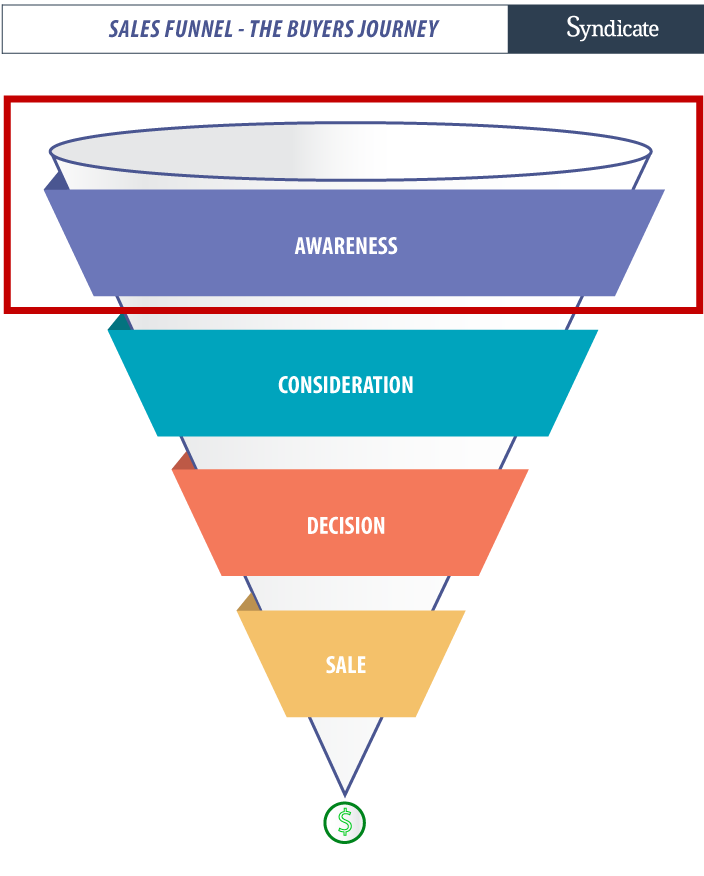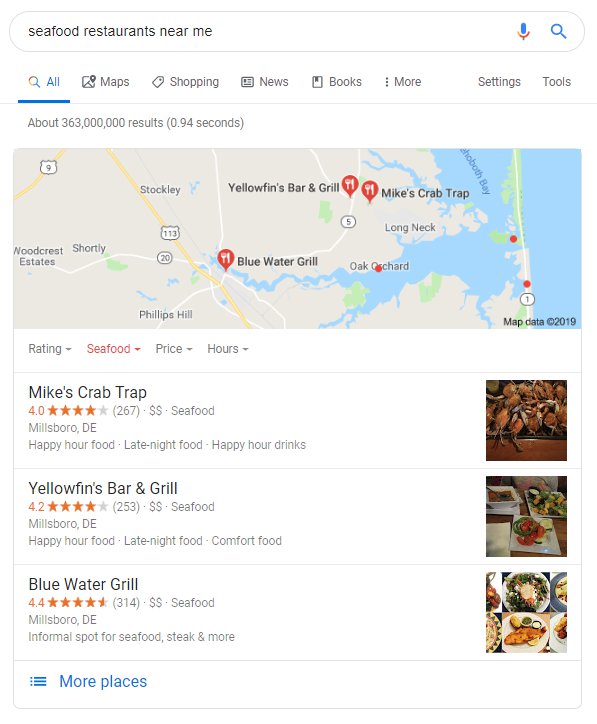Increasing Brand Visibility Online: Platforms, Options, Timeline and Budget
What brand awareness strategy is right for your business?
This blog was written to help business owners who are cultivating a marketing strategy for raising awareness for their business.
Preface: Before considering any of these options we recommend a comprehensive audit to identify pinch points and gaps in your strategy. Raising awareness isn’t always the right marketing strategy. If your business has high visibility but low conversion we would explore a strategy to improve the visitors your website is already receiving instead of pushing more people to a low-converting website. There is no “silver bullet” when it comes to your strategy, each of these options has a unique purpose in driving leads into your marketing funnel.
The options in this blog are meant to drive leads into the top of your sales funnel, but it’s important to state that each phase of the funnel is important. Raising awareness is just one component of a holistic and performance-driven Marketing Strategy.
Strategies for raising awareness
Raising awareness is important for new and established businesses alike. Do you have a new business? Does your target market know about your brand, services, and promotions? For most businesses, raising awareness is a common goal. Here are a few platforms you can leverage to reach this goal.

SEO
SEO (Search Engine Optimization) leverages search engine platforms like Google. SEO can be very technical at times, but the overall concept is fairly simple: Search Engines reward properly optimized websites with high-quality content. If your focus is on providing your website users with high-quality content Search Engines will take notice and improve your websites keyword rankings on their platforms.
Pros
- Search Engine traffic is often times higher quality considering it’s inbound in nature. IE – users are seeking answers to a problem they already know they have.
- Typically provides the highest ROI since traffic gained through Search Engines is non-paid (besides having to invest in content creation and optimization).
- Results from SEO do not (typically) cease once a campaign ends. Content optimized and published will continue to rank for keywords long after you stop a campaign – ultimately paying dividends in the form of Search Engine traffic over time.
Cons
- The competitive space for SEO is typically very saturated, gaining rankings over competitors can take significantly longer than acquiring traffic through paid ads (PPC/Google Ads).
- SEO often times requires content creation which can be a hurdle considering the complexity of your business’s product or service. Additionally, content creation can be time-consuming and/or expensive if outsourced.
- If your target market is not aware of your services they won’t be searching for solutions in search engines. If your business offers a new product or service users will need to be reached through other outbound channels – but it is still crucial to optimize your website for SEO so your audience can find your brand when searching online.
Timeline
- Optimizing a website depends on the size of the sitemap, but an initial optimization can take 2 – 4 weeks.
- Once a website has been optimized, changes can take several months to take effect.
- Depending on how competitive your market space is, ongoing SEO efforts such as publishing new content is a good strategy for improving rank.
Budget
- A one-time optimization can cost anywhere from $1500 and up depending on the complexity of the website and how severe the errors and warnings are. Ie: If your website isn’t mobile responsive, or has a significant amount of SEO errors you may want to consider overhauling the website completely since it can often time be a cost-effective solution – but this is for extreme cases.
How effective is your SEO? We can help you find out!
Google Ads/PPC
Running paid ads in Search Engines is a great way to get rankings much faster than SEO. You’ll be able to expedite Search Engine rankings by setting up an account like Google Ads.
Pros
- Ability to quickly rank for keywords your target market is searching for in Search Engines
- Tons of data available for optimizing campaigns, and accurately measure ROI.
Cons
- You need to “pay to play”, and it isn’t always cheap.
- All performance ceases to exist once the campaign is finished.
Timeline
- A well ran PPC campaign requires setting up “landing pages” which can require custom design and/or development depending on the type of content management system your website employs. These landing pages can take anywhere from 2 – 6 weeks to complete.
- Additionally, a good PPC campaign requires keyword research and competitive analysis, something that typically takes around 2 – 3 weeks. All in all, you’re looking at about a month to launch and several more months to optimize for performance.
Budget
- Budget depends on how many keyword groups you’re business wants to target. Management fees typically run about 15% of the entire ad spend and another $500-$1500 for the campaign setup.
Interested in learning more about PPC?
Social Media
Social Media Marketing leverages platforms such as Facebook, Linkedin, YouTube, Instagram, Pinterest and many more. Social Media Marketing is very diverse which is why it can serve customers at every stage of the marketing funnel. For the sake of this blog post, we will be exploring social media as a means to reach new audiences by way of a paid ad campaign.
Pros
- It is much cheaper to run a campaign on Facebook than it is to run the same ads on Googles Ad Network.
- Social Media platforms have robust data on their users which makes targetting much more effective than other ad networks.
- There is a social network for almost every target market and buyer persona.
- Ability to raise awareness for new products or services which your target market may not be aware of.
- Improved SEO rankings from “social signals“.
Cons
- Paid ad spend it often times required if you expect to generate results. Using social media without a paid ad spend is often times cost prohibitive since the visibility of business posts don’t get much exposure.
- An ongoing paid campaign is necessary to continue lead generation.
- Risk negative publicity if your audience isn’t happy with your offer.
Timeline
- Typically, a single social media campaign ran on 1 platform will take about 2 – 4 weeks to develop and launch.
- Testing and optimizing ads for improved performance should be conducted on a monthly basis. A paid Social Media Campaign can take 3 – 6 months to reach its full ROI potential.
Budget
- Budget depends on how many ad sets you’re business wants to run, and how many platforms you want to run them on. Management fees for running 5 ad sets can costs around $500 a month per platform (on average). Ad spends are variable based on how aggressive your campaign is, and the audience being targetted.
Think Social Media might work for your business?
Local Optimization: The 3 Pack
If your business serves customers on-site then you’ll want to show up in places like “Google Maps“. Optimizing for the “3 pack” is critical because it’s often times the first thing users see when searching for your products or services in Google. Running a campaign to display in the 3 pack requires setting up and optimizing many local accounts like Google My Business, and Yellow Pages. This is just one of many ranking factors involved with the 3 pack. If you’d like to learn more, check out this excellent blog written by WebFX.
Ex of the 3 pack:

Pros
- Displays your brand in prime search engine real estate without having to pay – however, paid placement is also a valuable feature if you’re looking to “double down”.
- Optimizing for the local 3 pack has a lot of similarities with optimizing for Voice Search – like Siri or OK-Google. Learn more about Voice Search here.
- Much of the work done to optimize for the 3 pack is a one-time fee – so you’ll reap the benefits of the campaign long after it’s been completed. However, other services, such as reputation management (generating online reviews), can be added to help boost these rankings over time as well.
Cons
- If you’re listing isn’t in the first 3 spots, you won’t display in the 3 pack.
- Your listing limited to users who are in local proximity to your business address – so acquiring national clients through local is not likely.
- If your business listings don’t have a lot of reviews or high reviews, you’ll be less likely to show up in the 3 pack. You’re at the mercy of your customer satisfaction.
Timeline
- In order to properly optimize for the 3 pack, you’ll need to create/update hundreds (if not thousands) of local listings to be accurate and robust. Luckily, there are services out there to help. This typically takes 3-4 weeks to complete.
- If your website doesn’t have content related to your products, services, and location, you’ll need to create it. Content creation can take 2 – 8 weeks depending on the complexity of your products and/or services.
- There are several other ranking variables, many of which are synonymous with SEO optimization which can take 1 – 2 months to complete.
- Total timeline to properly optimize for the 3 pack is roughly 4 – 8 weeks and 2-3 months to see the fruits of your labor.
Budget
- Optimizing for the 3 pack is typically done in tandem with optimizing for SEO considering their many similarities. This is typically $1500.
- Further optimization to local accounts can cost between $500 – $1000 per business location.
Are you optimized for local?
Conclusion
Although there are many options for improving business awareness, none are quite as cost-effective, or performance driven as the ones outlined in this blog. Each of these options provides measurable ROI and the ability to track, measure and optimize to improve results over time. Sure, you can buy a billboard, TV ad, or radio advertisements, but those options are quickly becoming obsolete in the digital age.
If you have any questions, comments or suggestions, please don’t hesitate to reach out and drop us a line! We hope you’ve enjoyed this blog and look forward to hearing from you!





